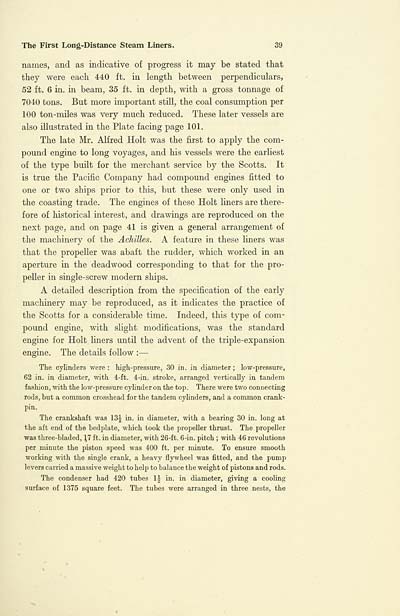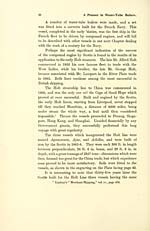Download files
Complete book:
Individual page:
Thumbnail gallery: Grid view | List view

The First Long-Distance Steam Liners. 39
names, and as indicative of progress it may be stated that
they were each 440 ft. in length between perpendiculars,
52 ft. 6 in. in beam, 35 ft. in depth, with a gross tonnage of
7040 tons. But more important still, the coal consumption per
100 ton-miles was very much reduced. These later vessels are
also illustrated in the Plate facing page 101.
The late Mr. Alfred Holt was the first to apply the com-
pound engine to long voyages, and his vessels were the earliest
of the type built for the merchant service by the Scotts. It
is true the Pacific Company had compound engines fitted to
one or two ships prior to this, but these were only used in
the coasting trade. The engines of these Holt liners are there-
fore of historical interest, and drawings are reproduced on the
next page, and on page 41 is given a general arrangement of
the machinery of the Achilles. A feature in these liners was
that the propeller was abaft the rudder, which worked in an
aperture in the deadwood corresponding to that for the pro-
peller in single-screw modern ships.
A detailed description from the specification of the early
machinery may be reproduced, as it indicates the practice of
the Scotts for a considerable time. Indeed, this type of com-
pound engine, with slight modifications, was the standard
engine for Holt liners until the advent of the triple-expansion
engine. The details follow : —
The cylinders were: high-pressure, 30 in. in diameter; low-pressure,
62 in. in diameter, with 4-ft. 4-in. stroke, arranged vertically in tandem
fashion, with the low-pressure cylinder on the top. There were two connecting
rods, but a common crosshead for the tandem cylinders, and a common crank-
pin.
The crankshaft was 13£ in. in diameter, with a bearing 30 in. long at
the aft end of the bedplate, which took the propeller thrust. The propeller
was three-bladed, ^7 ft. in diameter, with 26-ft. 6-in. pitch ; with 46 revolutions
per minute the piston speed was 400 ft. per minute. To ensure smooth
working with the single crank, a heavy flywheel was fitted, and the pump
levers carried a massive weight to help to balance the weight of pistons and rods.
The condenser had 420 tubes 1| in. in diameter, giving a cooling
surface of 1375 square feet. The tubes were arranged in three nests, the
names, and as indicative of progress it may be stated that
they were each 440 ft. in length between perpendiculars,
52 ft. 6 in. in beam, 35 ft. in depth, with a gross tonnage of
7040 tons. But more important still, the coal consumption per
100 ton-miles was very much reduced. These later vessels are
also illustrated in the Plate facing page 101.
The late Mr. Alfred Holt was the first to apply the com-
pound engine to long voyages, and his vessels were the earliest
of the type built for the merchant service by the Scotts. It
is true the Pacific Company had compound engines fitted to
one or two ships prior to this, but these were only used in
the coasting trade. The engines of these Holt liners are there-
fore of historical interest, and drawings are reproduced on the
next page, and on page 41 is given a general arrangement of
the machinery of the Achilles. A feature in these liners was
that the propeller was abaft the rudder, which worked in an
aperture in the deadwood corresponding to that for the pro-
peller in single-screw modern ships.
A detailed description from the specification of the early
machinery may be reproduced, as it indicates the practice of
the Scotts for a considerable time. Indeed, this type of com-
pound engine, with slight modifications, was the standard
engine for Holt liners until the advent of the triple-expansion
engine. The details follow : —
The cylinders were: high-pressure, 30 in. in diameter; low-pressure,
62 in. in diameter, with 4-ft. 4-in. stroke, arranged vertically in tandem
fashion, with the low-pressure cylinder on the top. There were two connecting
rods, but a common crosshead for the tandem cylinders, and a common crank-
pin.
The crankshaft was 13£ in. in diameter, with a bearing 30 in. long at
the aft end of the bedplate, which took the propeller thrust. The propeller
was three-bladed, ^7 ft. in diameter, with 26-ft. 6-in. pitch ; with 46 revolutions
per minute the piston speed was 400 ft. per minute. To ensure smooth
working with the single crank, a heavy flywheel was fitted, and the pump
levers carried a massive weight to help to balance the weight of pistons and rods.
The condenser had 420 tubes 1| in. in diameter, giving a cooling
surface of 1375 square feet. The tubes were arranged in three nests, the
Set display mode to:
![]() Universal Viewer |
Universal Viewer | ![]() Mirador |
Large image | Transcription
Mirador |
Large image | Transcription
Images and transcriptions on this page, including medium image downloads, may be used under the Creative Commons Attribution 4.0 International Licence unless otherwise stated. ![]()
| Histories of Scottish families > Two centuries of shipbuilding by the Scotts at Greenock > (87) Page 39 |
|---|
| Permanent URL | https://digital.nls.uk/95739707 |
|---|
| Description | A selection of almost 400 printed items relating to the history of Scottish families, mostly dating from the 19th and early 20th centuries. Includes memoirs, genealogies and clan histories, with a few produced by emigrant families. The earliest family history goes back to AD 916. |
|---|

